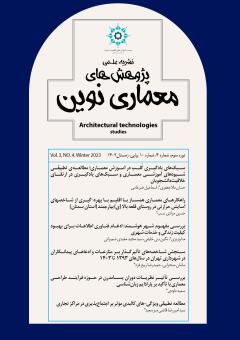مطالعه تطبیقی ویژگی¬های کالبدی مؤثر بر اجتماع¬پذیری در مراکز تجاری
محورهای موضوعی :
1 - دانشگاه آزاد اسلامی قزوین، قزوین، ایران.
کلید واژه: اجتماع¬پذیری, پایداری اجتماعی, طراحی مراکز تجاری, روانشناسی محیط, معماری مراکز عمومی,
چکیده مقاله :
تهران بهعنوان پایتخت سرآغاز و نمادی از تغییرات مدرن همراه با توسعه گسترده در بخش طراحی فضاهای عمومی شناخته شده است. این بناها نقش مهمی در بهبود ارتباطات و تعاملات اجتماعی افراد داشته و بررسیها نشان میدهند که لازم است تحلیلهای اجتماعی در فرآیند طراحی موردتوجه قرار گیرد. در این خصوص، کاربری تجاری بهعنوان قلمروهای مشترک برای تعاملات اجتماعی، ارتباطات و معرفت اجتماعی بازتاب شهری مؤثری دارند. عدم توجه به این مهم ممکن است منجر به از بین رفتن زنجیره ارتباط بین انسانها و فضاهایی عمومی شود. جایگاهی که میتواند ریشه تعاملات اجتماعی را شکل دهد، امکان دارد بهمرور آثار اجتماعی نامطلوبی ازجمله انزوا، ناراحتهای روحی و روانی را در جامعه انعکاس دهد. در این موضوع، طراحی و معماری مراکز تجاری نقشی بسیار برجسته دارد و ضرورت دارد پژوهش¬های بیشتری در باب اجتماعپذیری مراکز انجام شود. هدف اصلی این پژوهش تطبیقی، بررسی و مقایسه مؤلفههای تأثیرگذار بر اجتماعپذیری مبتنی بر ویژگیهای معماری در عملکرد تجاری در دو کالبد متفاوت، یعنی بازارهای سنتی و پاساژهای مدرن است. نمونههای موردی این مطالعه شامل، بازار بزرگ پانزده خرداد تهران و مرکز تجاری کوروش میباشند. این پژوهش با استفاده از مطالعات کتابخانهای، پرسشنامه و مصاحبه عمیق و مشاهده از روش تحقیق آمیخته بهصورت کمی و کیفی به بررسی موضوع میپردازد. از تحلیل نتایج می¬توان بیان ساخت که مجتمع¬های تجاری چند کاربردی، بهواسطه عوامل ساختاری محیطی، با ایجاد ابعادی از امنیت فراگیرتر از اجتماعپذیری بیشتری در مقایسه با بازارهای سنتی برخوردار هستند.
The city of Tehran, as the capital of Iran, has been undergoing a significant transformation in terms of modern changes and extensive development in public center design. Commercial complexes are considered as common domains for social interactions, communications, and social cognition, reflecting effective urban aspects. However, the neglect of social analysis in the design process may lead to the loss of communication between individuals and public spaces, which can result in undesirable social consequences and psychological and emotional distress within society such as isolation and Social alienation. In this regard, the design and architecture of commercial centers have a prominent role, and further research on the social acceptability of these centers is necessary. The main objective of this comparative research is to examine and compare the influential components of social acceptability based on architectural features in the commercial performance of two different structures, namely traditional market centers and malls. The case studies of this research include the Grand Bazaar of Tehran and Kourosh Mall. This study employs a mixed-method approach, utilizing library research, questionnaires, in-depth interviews, and observations, to investigate the subject both quantitatively and qualitatively. Analysis of the results demonstrates that multi-purpose commercial complexes, through environmental structural factors, possess higher levels of overall acceptability compared to traditional markets, by developing dimensions of greater security. This research contributes to the field of architecture and urban design by highlighting the importance of social analysis in the design process and identifying the influential components of social acceptability in commercial centers.
